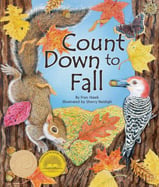Alignment to Standards for IN

| Grade | Number | Standard |
|---|---|---|
| 1 | SC-1.1.1 | Observe, describe, draw, and sort objects carefully to learn about them. |
| 1 | SC-1.1.2 | seek answers to questions about the world, such as –In what ways do animals move?” |
| 1 | SC-1.2.6 | Describe and compare objects in terms of number, shape, texture, size, weight, color, and motion. |
| 1 | SC-1.4.2 | Observe and describe that there can be differences, such as size or markings, among the individuals within one kind of plant or animal group. |
| 1 | SC-1.4.3 | animals eat plants or other animals for food. |
| 1 | SC-1.5.1 | Use numbers, up to 10, to place objects in order, such as first, second, and third, and to name them |
| 1 | SS-1.3.6 | Explain the effect of seasonal change on plants, animals, and people. |
| 1 | SS-1.4.1 | Identify goods that people use. |
| 2 | SC-2.3.1 | some events in nature have a repeating pattern, such as seasons, day and night, life cycles, and migrations. |
| 2 | SC-2.3.1 | Investigate by observing and then describe that some events in nature have a repeating pattern, such as seasons, day and night, life cycles, and migrations. |
| 2 | SC-2.3.4 | animals and plants sometimes cause changes in their surroundings. |
| 2 | SC-2.4.1 | Observe and identify different external features of plants and animals and describe how these features help them live in different environments. |
| 2 | SC-2.4.2 | Observe that and describe how animals may use plants, or even other animals, for shelter and nesting. |
| 2 | SC-2.4.4 | living things are found almost everywhere in the world and that there are somewhat different kinds in different places. |
| 2 | SC-2.4.5 | materials in nature, such as grass, twigs, sticks, and leaves, can be recycled and used again, sometimes in different forms, such as in birdsê nests. |
| 3 | SC-3.3.5 | Give examples of how change, such as weather patterns, is a continual process occurring on Earth. |
| 3 | SC-3.4.1 | living things can be sorted into groups in many ways using various features, such as how they look, where they live, and how they act, to decide which things belong to which group. |
| 3 | SC-3.4.2 | Explain that features used for grouping depend on the purpose of the grouping. |
| 3 | SC-3.4.4 | all kinds of animalsê food can be traced back to plants. |
| 4 | SC-4.4.3 | organisms interact with one another in various ways, such as providing food, pollination, and seed dispersal. |
| 4 | SC-4.4.4 | some source of energy is needed for all organisms to stay alive and grow. |
| 5 | SC-5.4.4 | Explain that in any particular environment, some kinds of plants and animals survive well, some do not survive as well, and some cannot survive at all. |
| 5 | SC-5.4.4 | in any particular environment, some kinds of plants and animals survive well, some do not survive as well, and some cannot survive at all. |
| K | SC-K.2.1 | Use whole numbers*, up to 10, in counting, identifying, sorting, and describing objects and experiences. |
| K | SC-K.4.1 | Give examples of plants and animals. |
| K | SC-K.4.2 | plants and animals, describing how they are alike and how they are different in the way they look and in the things they do. |
| K | SC-K.6.1 | Describe an object by saying how it is similar to or different from another object. |
| K | SS-K.3.5 | seasonal weather changes and weather affects people and the environment. |